“There must be a better way to make the things we want, a way that doesn’t spoil the sky, or the rain or the land”
~ Paul McCartney
In the modern world of rapid urbanization and growing pollution, it’s not easy to sustain a greener and safer world for us to live in. There is an increased concern about sustainability in recent years. Companies are ramping up their environment and social commitments as well. While many companies have been investing in the required Environmental, Social and Governance (ESG) for the sake of regulations and laws, many are now investing in these activities such as sustainable procurement beyond compliance for increasing corporate value and market differentiation. Just to make sure we are on the same page, ESG refers to a collection of corporate performance evaluation criteria that assess the robustness of a company’s governance mechanisms and its ability to effectively manage its environmental and social impacts.
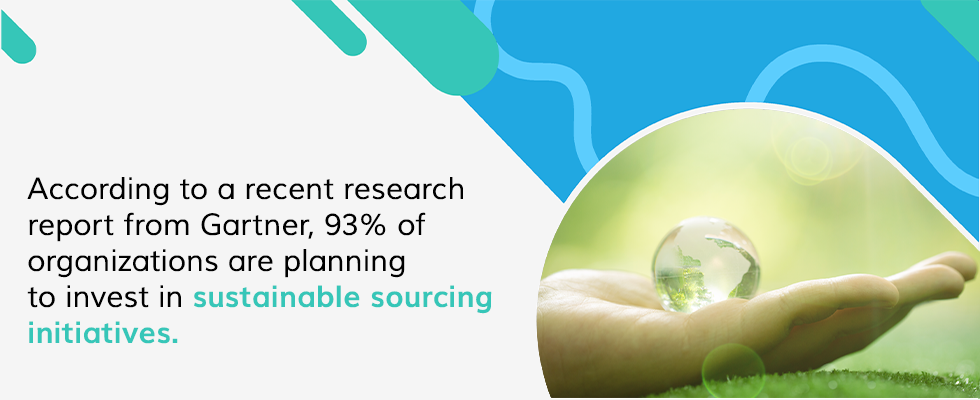
A huge part of the push for ESG is the way organizations spend – what, how and from whom they source. Hence sustainable procurement practices become a critical factor in helping organizations achieve their ESG goals. According to a recent research report from Gartner, 93% of organizations are planning to invest in sustainable sourcing initiatives. However, we have seen procurement leaders looking to build a sustainable sourcing strategy often struggle to identify what environmental, social and governance (ESG) issues they should incorporate into their sourcing and procurement strategy. In this blog, we try to break down sustainable procurement, and its outcomes as well as shed some light on how to build an effective sustainable procurement strategy and the tools that could help with it.
Inhaltsverzeichnis
ToggleWhat is Sustainable Procurement/Sustainable Sourcing and Why does it Matter?
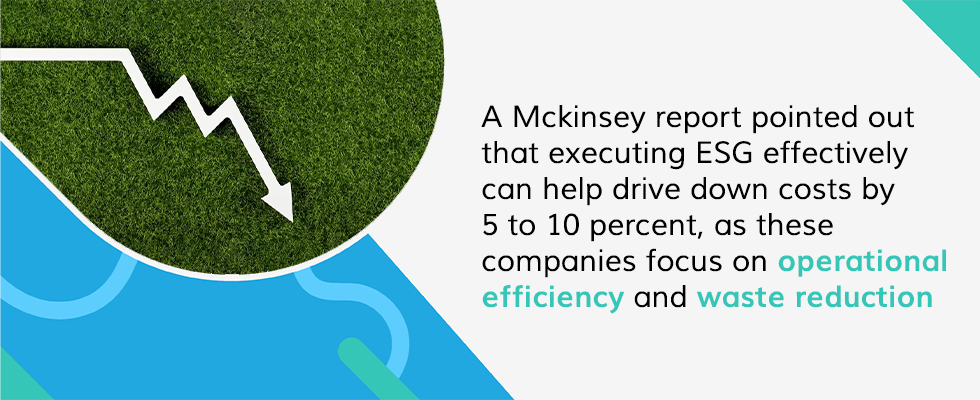
Sustainable procurement or sustainable sourcing, also often referred to as responsible sourcing is an approach to sourcing materials where an organization consciously considers social, ethical and environmental factors along with the typical cost and quality factors, in the process of selecting suppliers.
Ensuring that prospective suppliers comply with social and environmental standards is critical in limiting the organization’s risk exposure from the supply base. Many countries and governments are enforcing companies to incorporate environmental and social protection into their supply chain processes. For example, Germany has passed the German Supply Chain Due Diligence Act which will be effective from January 2023 and mandates larger companies to conduct supply chain due diligence activities.
Effective sustainable procurement practices can not only help in ensuring compliance and mitigating risks but also deliver other outcomes such as brand differentiation enabling revenue growth and ecosystem enablement where a company along with their peers go a step further to impact a common issues such as deforestation, water use, greenhouse gas emission, etc.
Moreover, procurement organizations also report benefits in supplier collaboration, sales, brand perception, and product/service quality. A Mckinsey report pointed out that executing ESG effectively can help drive down costs by 5 to 10 percent, as these companies focus on operational efficiency and waste reduction. In a Deloitte survey, the top benefits selected by respondents were brand recognition and reputation, and customer satisfaction.
Major benefits of responsible sourcing programs:
- Improved product/service quality
- Improved compliance with legislation/regulation
- Reduced supply chain risks
- Improved supplier relationships
- Lowers costs
- Improved brand perception
- Improved employee satisfaction
- Innovation around offerings and/or operations
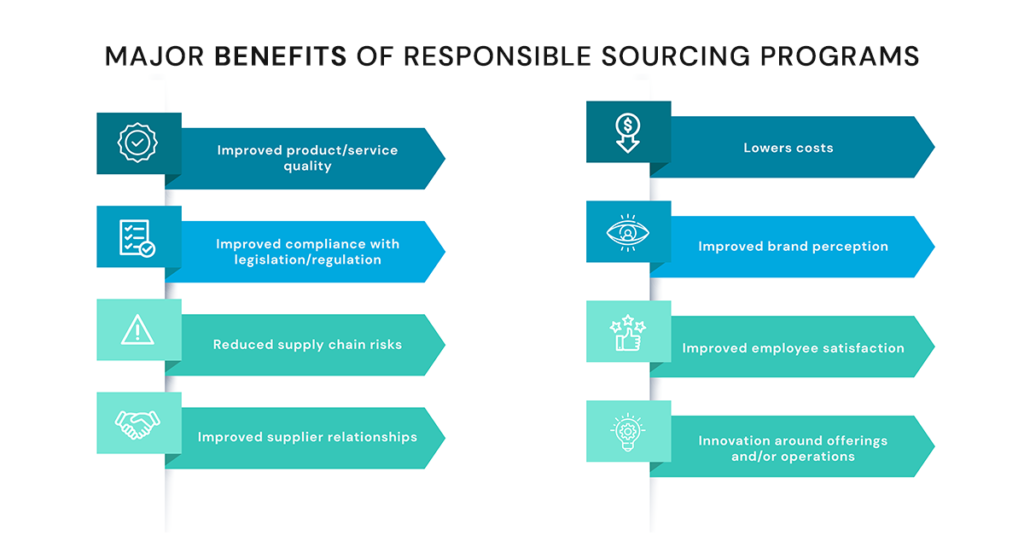
Implementing a Sustainable Sourcing Strategy
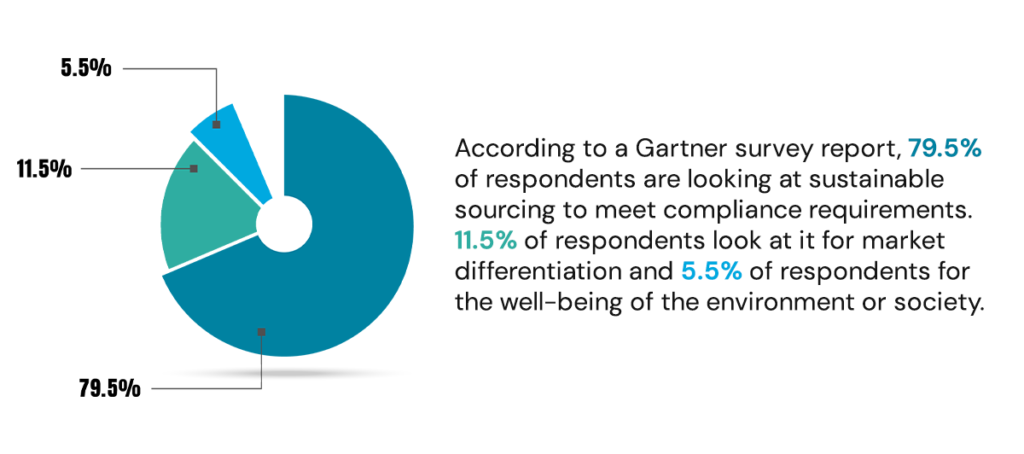
Responsible sourcing has been around for a while now. But the initiatives in most companies are still not very comprehensive and are mostly limited to compliance and check-the-box activities such as a supplier code of conduct. While there are some baseline activities every organization to adhere to from a compliance perspective, it’s completely up to the organization to decide on the positive impact they wish to create and set their ESG goals. According to a Gartner survey report, 79.5% of respondents are looking at sustainable sourcing to meet compliance requirements defined by local and global regulations and norms. However, 11.5% of respondents look at it for market differentiation and 5.5% of respondents go a step further to impact a long-term common goal for the well-being of the environment or society.

Whatever the goals are, for procurement organizations to improve the effectiveness of their sustainable sourcing strategy, they need to define the objectives and scope they want to achieve and then incorporate responsible sourcing criteria into their supplier lifecycle management. The key steps to be followed to have a sustainable sourcing strategy in place are:
1. Define the scope of your responsible sourcing strategy
2. Define and communicate expectations to suppliers
3. Validate supplier adherence to responsible sourcing requirements 4. Remediation and capability building
Steps for Implementing a Sustainable Sourcing Process

1. Define the scope of your responsible sourcing strategy
As a first step, procurement organizations must define the scope of their responsible sourcing strategy by defining the outcome and level of ambition they are pursuing – is it compliance, market differentiation or ecosystem enablement. Many organizations often start with a compliance-focused approach, but their goals may evolve as their ambitions grow to support their brand differentiation strategy or higher goals for contributing to addressing a global issue.
2. Define and communicate expectations to suppliers
Once the scope of the responsible sourcing strategy has been defined, the next step is to define and communicate your responsible sourcing requirements and expectations to prospective suppliers. It can be in the form of a responsible sourcing policy (supplier code of conduct) with a set of labor, health, safety and environmental requirements that suppliers are expected to adhere to and other expectations beyond these compliance requirements to focus on wider sustainability issues based on your ambitions as well.
Once the policy is in place, the next step will be to communicate your organization’s responsible sourcing policies to your suppliers to give them a common understanding of your expectations and standards. Organizations should incorporate the responsible sourcing requirements in the bidding process, supplier selection and onboarding processes for new and prospective suppliers through bidding materials such as RFQ packs. For established suppliers, terms and conditions included in supplier contracts and purchase orders should include a provision referencing the responsible sourcing policy.
3. Validate supplier adherence to responsible sourcing requirements
Just communicating responsible sourcing requirements to your suppliers cannot ensure suppliers adhere to such requirements. Procurement also needs to validate supplier adherence to the policies before contracts are awarded by assessing risk and gauging their performance. This process of validation and assessment should continue throughout the relationship with the supplier.
Organizations can use various platforms for validation such as requesting the supplier to do a self-assessment to understand current performance and gain deeper insight into potential risks, mandate document submissions for proof during the onboarding process, use data from external sources to understand the supplier’s performance against the requirements, etc. This information helps you assess suppliers and make a shortlist of suppliers who can meet your responsible sourcing criteria and rank them based on risk. Based on risk assessment, organizations may choose to do on-site audits of prospective suppliers, especially for those who demonstrate poor adherence to requirements or there is a significant contextual risk.
4. Remediation and capability building
Once the supplier adherence data is validated, corrective actions may be issued to suppliers who did not meet expectations or in case of significant failures against basic compliance requirements, the supplier may have to be terminated. However, in the case of sustainable sourcing requirements that focus on wider sustainability issues, such as greenhouse gas reduction, many suppliers may not be able to assess and allocate their greenhouse gas emissions. Hence, based on a capability assessment of suppliers, you can go for a supplier collaboration and innovation agenda to help suppliers work on improving their capability.
Challenges in Implementing Sustainable Procurement
Increasingly complex and globalized supply chains increase responsible sourcing risks, such as labor exploitation, environmental pollution and unsafe working conditions making sustainable procurement all the more complex. Many organizations have sustainable procurement policies in place. But the question is to what extent are they able to comply with these policies. Assurance of compliance to these policies can only come through the implementation of a set of due diligence activities such as supplier risk assessment, supplier self-assessment, audits, ESG risk performance information from third-party tools, etc.
Some of the most common challenges organizations experience while adopting such responsible sourcing initiatives are:
- Sustainable supply may be more expensive.
- Sustainability initiatives are difficult to monitor and enforce.
- Assessing and managing a large supply base becomes challenging
- Managing misalignment between sustainable sourcing goals and procurement metrics is difficult
How can Technology Aid your Sustainable Sourcing Strategy?
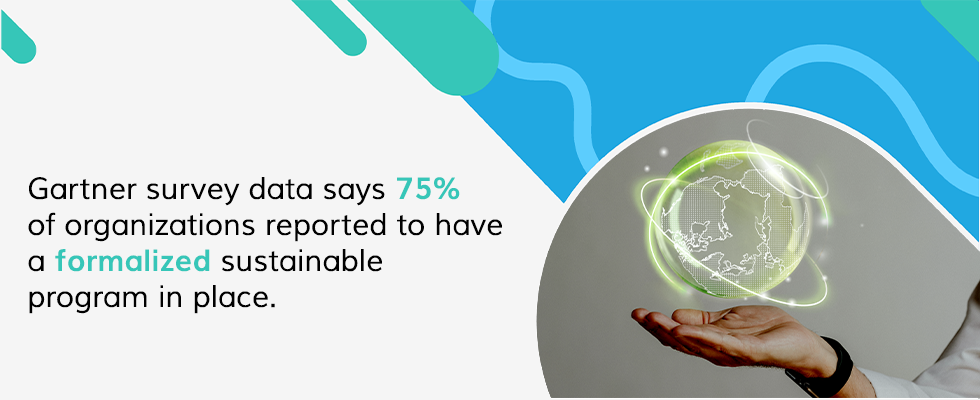
Gartner survey data says 75% of organizations reported to have a formalized sustainable program in place. However, many of these organizations limit the scope of their responsible sourcing strategy to creating a sustainable sourcing policy that outlines the expectations of suppliers. They often do not have the resources and capability to assess and verify supplier adherence to these policies and incorporate them throughout the supplier lifecycle.
Luckily, there are a lot of solutions available in the market to support your responsible sourcing efforts. These tools can help organizations with supplier data collection and assessments. Sourcing and supplier management solutions can help organizations fine-tune and incorporate sustainable procurement into the supplier lifecycle management, bidding and Vertragsmanagement processes.
The different types of application that can help organization ramp up their sustainable procurement initiatives are:
Supplier Sustainability Applications
The adoption of supplier sustainability solutions is still very limited but expected to accelerate due to increasing investments towards ESG initiatives by companies recently. Many organizations looking at scaling their responsible sourcing programs are increasinglydeploying supplier sustainability and ESG risk monitoring solutions to monitor their suppliers’ responsible sourcing performance to reduce their risk exposure and drive improvements. These solutions enable organizations to collect and assess supplier performance on responsible sourcing requirements covering ESG issues.
These solutions usually provide a supplier sustainability score to suppliers based on an established list of parameters they use to assess the supply base. While some solutions focus on a wide range of regulatory compliance issues, others are specialized in specific issues such as workforce conditions, greenhouse gas emissions, etc. Some of them also provide scores based on customized assessments on different ESG topics based on your company’s requirements.
Some of the popular solutions are EcoVadis, Benchmark ESG, Source Intelligence, iPoint, etc.
Solutions like Sedex and EcoVadis also offer solutions for virtual audits and supplier development with the provision to provide supplier feedback.
ESG risk data source and monitoring solutions
These solutions monitor supplier performance and risks in real-time based on a a broad range of data sources. Vendors in this space often focus on broader supply chain risk indicators apart from ESG such as cybersecurity, financial, geopolitical and other topics. Sample vendors offering risk monitoring solutions are Resilinc, Interos and Prewave.
Worker engagement tools
These applications enable direct communication with the workers at your supplier factories enabling you to collect their feedback on any issues they face or concerns. These solutions enable a bottom-up approach to addressing sustainability issues in the supplier’s workplace and verify them. These solutions also enable you to provide training material for improving awareness of worker rights among your suppliers’ workforce and facilitate raising of concerns via hotlines or other mediums for reporting. Some of the vendors providing worker engagement tools are Ulula, &Wider and Quizrr.
Supplier Relationship Management solutions
One of the most important aspects of managing a sustainable sourcing program effectively is the ability to manage your supply base effectively and embed your sustainable procurement policy throughout the supplier lifecycle. Lieferantenbeziehungsmanagement solutions provide a platform to automate and streamline your supplier management processes – from onboarding to ongoing performance management and collaboration. SRM solutions enable you to manage the entire supplier lifecycle, supplier data, workflows, hierarchies, risk, performance and compliance. Many SRM solutions like MeRLIN also offer useful features to incorporate responsible sourcing like supplier evaluation surveys, rule-based workflows for supplier onboarding by mandating and verifying supplier certifications and other documents, a real-time collaboration platform, analytics and reporting to monitor supplier performance, etc.
Sourcing solutions
Building responsible sourcing requirements into the sourcing and supplier selection process ensures that the organization has a more holistic view of responsible sourcing risks before entering a relationship with the supplier. Hence, fine-tuning your sourcing events by including a detailed overview of the responsible sourcing policies in the RFQ pack and collecting required information from the suppliers to evaluate them based on your responsible sourcing criteria, in addition to other parameters such as cost and quality, is important.
eSourcing solutions can help streamline the entire process of supplier identification and selection based on sourcing criteria and significantly shorten the sourcing cycle through automation of workflows and faster decision-making.
Reporting and analytics tools
Analytics solutions help companies to report and analyze data from assessments with intuitive dashboards. This enables companies to easily report on social compliance, human rights and sustainability performance within their supply chains to internal and external audiences.
Conclusion
Sustainable sourcing is gaining importance across all industries. Some might feel that growth and sustainability are conflicting ideas. However, there are fairly a large number of forward looking companies leading the way to prove the contrary and are already capturing real benefits from their efforts. Procurement has a decisive role to play in shaping the environmental footprint of organizations enabling them to drive growth through sustainability. Hence, procurement leaders should now equip themselves with the tools, data and capabilities needed to support the shift to sustainable business models.
To know more about how MeRLIN’s Strategic Sourcing and Supplier Management solutions can help drive your sustainable procurement initiatives, contact us.



